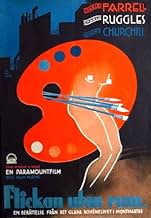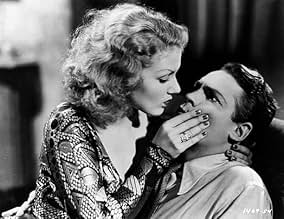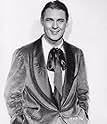Ajouter une intrigue dans votre langueYoung Tennessee painter Tom Duncan is thrilled to receive an art scholarship to Paris. When he arrives, he finds himself surrounded by a group of eclectic characters, as well as his beautifu... Tout lireYoung Tennessee painter Tom Duncan is thrilled to receive an art scholarship to Paris. When he arrives, he finds himself surrounded by a group of eclectic characters, as well as his beautiful new roommate Kay. Their potential relationship is soon threatened when fellow artists st... Tout lireYoung Tennessee painter Tom Duncan is thrilled to receive an art scholarship to Paris. When he arrives, he finds himself surrounded by a group of eclectic characters, as well as his beautiful new roommate Kay. Their potential relationship is soon threatened when fellow artists start to advise Tom to drink, and he falls in with a notorious gold-digger.
- Director
- Writers
- Stars
- Vergil Crock
- (as Charlie Ruggles)
- Arthur Copeland
- (as Walter Woolf)
- Gallopsky
- (as Leonid Kinsky)
- Sitsky
- (as Alexander Mellish)
- French Girl
- (uncredited)
- Child
- (uncredited)
- Doctor
- (uncredited)
- Woman
- (uncredited)
- French Girl
- (uncredited)
- Academy Judge
- (uncredited)
- Man at Art Awards
- (uncredited)
Avis en vedette
This is one of those abhorrent films where people speak for a lot of the time in rhyme or even in song. When the actors aren't singing, they're doing what was considered at the time, 'comedy acting' - equally horrendous! Paramount made a few of these weird brain-bleaching semi-operas in the early thirties. Another was THIS IS THE NIGHT, which like this, lured red-blooded males into the picture houses with pretty young ladies.
Charles Farrell was ok in some of his pictures but the peculiar nature of this aberration doesn't really allow him or anyone else to act. Charlie Ruggles however as the "modern artist" is almost tolerable.
Even if this wasn't designed by the church to punish sin, Paramount certainly made this to appeal to men. Marguerite Churchill, who was impossibly pretty is given the role of a dissolute, jaded American living in the sexually liberated Paris (as imagined by Hollywood) who spends her days in lacy underwear and an open silky robe. Unfortunately the writers seem to have forgotten to give her role any actual character. What a waste, she could be a great actress in a decent picture.
It also features sexy, sassy Grace Bradley and a couple of seconds of the infamous naked dancer, Joyzelle Joyner. That nude dancing scene is presented as a very, very blurred image from the point of view of Farrell who has been drinking alcohol - allowed in sinful Paris but a banned evil influence in the US. So we're led into a salacious world but told it is a bad, dark place.
There is a shadow in a plot - about the nature of art but really, this doesn't even try to be a normal film. Neither is it remotely funny.
The film is noteworthy for it's nightclub female dancer sequence, which lasts only about 5-10 seconds, & that's a shame. The dancer is the uncredited Joyzelle Joyner, & she dances without clothes! It's impossible to tell this from the film video, because she's shown for such a short period of time, & from the waist up, & more so, because of the outstanding body paint that was applied to her in a snake motif (shoulders to ankles).
I have seen three still photos of Joyzelle in character, in her painted "outfit", which show: 1) her full-body make-up being applied backstage by Makeup Artist David S. Garber, with "supervision" from a female assistant (actually, more of a "chaperone"); this photo is dated November 29 1933 (the date the photo was received by a photo service in New York City, not the date the photo was taken). 2) Joyzelle on the film set of "Girl Without a Room" at Paramount Studios in Hollywood, with the backdrop being the back wall of the nightclub scene set in the film. 3) a colorized photo of #2 above, with the backdrop edited out; this photo best shows the magnificence of the body paint; it appears on the front cover of "PIC" Magazine, May 2 1939.
Joyzelle's body make-up is possibly the most outstanding example of its kind in Hollywood history.
The movie starts off briskly with the events given in recitative, but it sags in the second half, despite Ruggles' quavering, good-natured nonsense and Grace Bradley as a peroxide Russian gold digger. It never quite recovers, but the lively first half and occasional bouts of nonsense keep it moving throughout.
Tom Duncan (Charles Farrell) has come to Paris to become a great artist. He soon falls in with a bunch of weirdo bohemians in an apartment building. Can Tom discover and unleash his great talent within and can he manage to win the girl by the end of the film?
This is an odd film. After all, a lot of the dialog is in rhyming prose! And, the characters are weird and keep popping into nearly every scene...much like you'd see in the movie "You Can't Take it With You". It's pleasant and fun...though a tad shrill...as if it's working just too hard to try to make you laugh.
Le saviez-vous
- AnecdotesOne of over 700 Paramount Productions, filmed between 1929 and 1949, which were sold to MCA/Universal in 1958 for television distribution, and have been owned and controlled by Universal ever since; its earliest documented telecast took place in Los Angeles Friday 3 June 1960 on The Classic Theatre series of the Late, Late Show on KNXT (Channel 2).
- ConnexionsReferenced in Billy Bathgate (1991)
- Bandes originalesYou Alone
Words by Val Burton
Music by Will Jason
Copyright 1933 by Donaldson, Douglas and Gumble, Inc.
Meilleurs choix
Détails
- Date de sortie
- Pays d’origine
- Langue
- Aussi connu sous le nom de
- Devojka bez sobe
- Lieux de tournage
- société de production
- Consultez plus de crédits d'entreprise sur IMDbPro
- Durée1 heure 18 minutes
- Couleur
- Rapport de forme
- 1.37 : 1
Contribuer à cette page





















